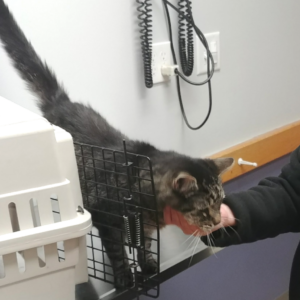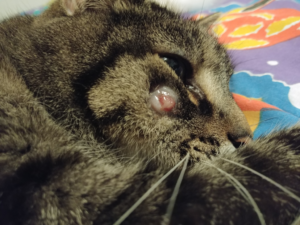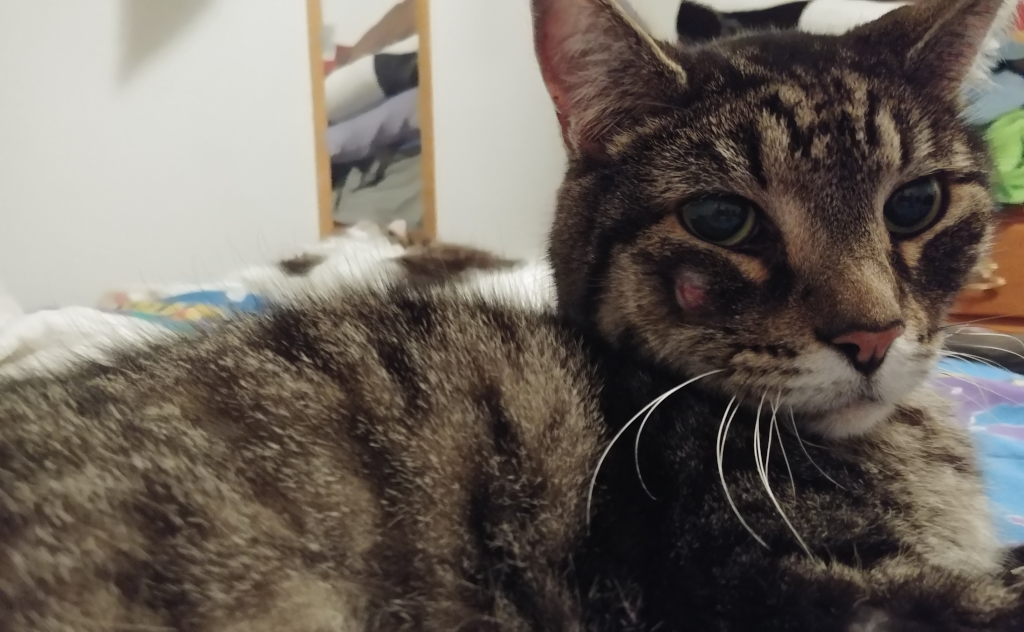 When Zippy first started having a dental issue, we thought it was just a normal dental visit to the vet. At 14 years old, our lovable cat had already overcome his fair share of health challenges, but nothing prepared us for what came next.
When Zippy first started having a dental issue, we thought it was just a normal dental visit to the vet. At 14 years old, our lovable cat had already overcome his fair share of health challenges, but nothing prepared us for what came next.
Zippy’s dental visit later transformed itself into squamous cell carcinoma (SCC), an aggressive form of cancer that would ultimately take our beloved companion from us.
We quickly started doing our research so we could better help zippy as well as easing his symptoms. Information today is much more readily available than it was in 2016 concerning SCC, so be sure to do yours if your dealing with a cate or pet with SCC,
Understanding Squamous Cell Carcinoma in Cats
Squamous cell carcinoma is one of the most common forms of skin cancer in cats. It develops in the squamous epithelial cells, which are flat, scale-like cells that make up the outer layer of the skin (epidermis) and the lining of hollow organs in the body. In cats, SCC can appear in several locations, but it most commonly affects:
- The skin, especially areas with sparse fur and high sun exposure
- The oral cavity, including the gums, tongue, and jawbone (as with Zippy)
- The ears, particularly the tips in white cats
- The nose, especially in light-colored cats
Oral squamous cell carcinoma, which affected our Zippy, accounts for approximately 10% of all feline cancers and is the most common oral cancer in cats. It’s particularly insidious because by the time symptoms become noticeable, the cancer has often already progressed significantly.
Risk Factors and Causes
What causes this devastating disease? While we never determined the exact cause of Zippy’s cancer, veterinary research has identified several risk factors:
-
Sun Exposure
 For skin SCC, prolonged exposure to ultraviolet (UV) radiation from the sun is a primary risk factor, especially for cats with white or light-colored fur, pink skin, or sparse hair coverage. Studies indicate that about 80% of cutaneous SCC cases in cats are associated with UV light exposure. Unlike Zippy’s oral form, skin SCC typically develops on exposed areas like the ears, nose, and eyelids.
For skin SCC, prolonged exposure to ultraviolet (UV) radiation from the sun is a primary risk factor, especially for cats with white or light-colored fur, pink skin, or sparse hair coverage. Studies indicate that about 80% of cutaneous SCC cases in cats are associated with UV light exposure. Unlike Zippy’s oral form, skin SCC typically develops on exposed areas like the ears, nose, and eyelids.
-
Environmental Toxins
The grooming habits of cats expose them to carcinogens such as cigarette smoke and chemicals in flea collars, which may increase their risk of developing oral squamous cell carcinomas. Cats living in smoke-filled environments are four times as likely to develop oral SCC, while studies suggest a possible link between wearing flea collars and cancer development, potentially due to the proximity of pesticides to the cat’s mouth.
-
Age
As with many cancers, age plays a significant role. SCC typically affects older cats with a median age of 9 to 11 years. Zippy was 14 when his symptoms first appeared, which falls within the typical age range for this diagnosis.
-
Viruses
Feline papillomavirus 2 has been detected in approximately 80% of squamous cell carcinomas in cats, suggesting a possible associated role in causing SCC. Research continues to investigate the viral etiology of feline oral squamous cell carcinoma, with papillomavirus being the most commonly scanned and identified virus in cats with this condition.
-
Chronic Inflammation
For lesions that occur in the oral cavity, chronic inflammation or chronic dental disease may be related factors, although researchers note that this connection isn’t definitively proven. This might have been a contributing factor for Zippy, who had struggled with dental issues earlier.
Recognizing the Signs of Squamous Cell Carcinoma
 Looking back, there are subtle signs you can recognize before they became impossible to ignore. For cats with oral SCC like Zippy, the warning signs can include:
Looking back, there are subtle signs you can recognize before they became impossible to ignore. For cats with oral SCC like Zippy, the warning signs can include:
- Difficulty eating or reluctance to eat
- Drooling, often with blood present
- Bad breath that doesn’t resolve with dental care
- Visible mass in the mouth
- Weight loss
- Pawing at the mouth or face
- Facial swelling
- Loose teeth without apparent dental disease
For Zippy, we noticed a subtle change in the shape of his cheek that progressively became more pronounced. Shortly after his dental appointment, his symptoms became more serious and the cancer had already invaded his jawbone.
The Diagnostic Journey
 Our experience with Zippy taught us that early diagnosis is crucial but often difficult. The diagnostic process for feline SCC typically involves:
Our experience with Zippy taught us that early diagnosis is crucial but often difficult. The diagnostic process for feline SCC typically involves:
- Physical Examination: A thorough examination of the affected area and surrounding tissues by a veterinarian that can recognize there’s potentially other issues.
- Imaging: X-rays, CT scans, or MRIs to determine the extent of the cancer and whether it has invaded bone or other structures.
- Biopsy: The definitive test for SCC, involving the removal of a small tissue sample for microscopic examination.
- Additional Testing: Blood work and other tests to assess overall health and determine if the cancer has spread.
In Zippy’s case, what was initially treated as a dental issue led to delayed diagnosis. By the time a biopsy confirmed SCC, the cancer had already progressed significantly, limiting our treatment options.
Treatment Options
For cats diagnosed early, there are several treatment approaches that might offer a better prognosis. With Zippy’s advanced age and progression of the disease, many options are unavailable.
-
Surgery
 Surgical removal of the tumor is often the first-line treatment when the cancer is caught early enough and is in an accessible location. For oral SCC, this can involve removing part of the jawbone (mandibulectomy or maxillectomy). Cats with tumors located along the front portion of their lower jaw have a better prognosis because surgery is more likely to be an option. While these procedures sound dramatic, many cats adapt remarkably well afterward, though feeding tubes may be needed temporarily or permanently during recovery.
Surgical removal of the tumor is often the first-line treatment when the cancer is caught early enough and is in an accessible location. For oral SCC, this can involve removing part of the jawbone (mandibulectomy or maxillectomy). Cats with tumors located along the front portion of their lower jaw have a better prognosis because surgery is more likely to be an option. While these procedures sound dramatic, many cats adapt remarkably well afterward, though feeding tubes may be needed temporarily or permanently during recovery.
-
Radiation Therapy
Radiation therapy is often used alone or in combination with surgery to target cancer cells, as these tumors tend to be sensitive to radiation while resistant to chemotherapy. Current protocols include accelerated radiation therapy, which involves multiple treatments over a short period. Some veterinary oncologists combine radiation with carboplatin chemotherapy to improve outcomes. Unfortunately, side effects due to radiation are common, which can add to a patient’s discomfort.
-
Chemotherapy and Targeted Treatments
While traditional chemotherapy agents like doxorubicin, cyclophosphamide, carboplatin, and mitoxantrone have shown limited effectiveness against SCC, newer targeted approaches are being investigated. Piroxicam and other non-steroidal anti-inflammatory drugs (NSAIDs) may help improve quality of life and have shown some anti-cancer activity in cats with normal kidney function. Pamidronate, a bisphosphonate that binds to bone, can help alleviate bone pain associated with oral SCC and can be administered intravenously every three to four weeks alongside other treatments.
Promising Research and Emerging Therapies
Several cutting-edge treatments are being developed that may transform how we treat SCC in cats:
- Nanobody-targeted photodynamic therapy uses tumor-cell targeted antibody fragments coupled with light-sensitive chemicals to precisely target cancer cells. Researchers at Utrecht University are investigating this approach, which could eliminate some drawbacks of conventional therapy.
- A feline RNA nanoparticle vaccine against oral squamous cell carcinoma is currently being studied at the University of Florida College of Veterinary Medicine, offering hope for prevention and treatment.
- Researchers are also exploring ways to block the processes by which tumors mobilize nutrients for growth, potentially “starving” the cancer cells.
Palliative Care
When curative treatment isn’t possible, as was the case with Zippy, palliative care focuses on maintaining quality of life for as long as possible. This includes pain management with medications, nutritional support through feeding tubes if necessary, and addressing specific symptoms. Prednisolone, a corticosteroid, can be used when cats are clinically unwell to reduce inflammatory responses associated with cancer and provide comfort.
With Zippy, we used Gabapentin to manage his pain along with steroidal treatment. Occasional a shot of Covenia (for infection) helped him out immensely bi-monthly and sometimes monthly. It really depended on his condition and comfort.
Our Journey with Zippy: Palliative Care at Home
 After receiving the devastating news that Zippy’s cancer was too advanced for curative treatment, we focused on making his remaining time as comfortable and joyful as possible. Our days centered around:
After receiving the devastating news that Zippy’s cancer was too advanced for curative treatment, we focused on making his remaining time as comfortable and joyful as possible. Our days centered around:
Pain Management: The veterinarian prescribed pain medications that we administered regularly (Gabapentin). We learned to recognize subtle signs that Zippy might be experiencing breakthrough pain, allowing us to adjust his medication schedule accordingly.
Nutritional Support: As eating became more difficult, we experimented with different food textures and temperatures. Soft, warm foods were easier for Zippy to manage, and we found that hand-feeding small amounts frequently worked better than offering larger meals.
Warm Compresses: Several times daily, we gently applied warm compresses to Zippy’s face, which seemed to provide comfort and reduce inflammation. These quiet moments became a special time of connection for us and him.
Creating Comfort: We arranged soft bedding in Zippy’s favorite spots throughout the house and ensured he had easy access to necessities without having to jump or climb.
Cherishing Time: Perhaps most importantly, we made a conscious effort to be present with Zippy. Whether sitting in sunbeams together or simply keeping him company during quiet hours, these moments became precious memories.
The Emotional Toll and Finding Support
Caring for a beloved pet with terminal cancer takes an immense emotional toll. The daily routine of medications, special feedings, and monitoring for signs of pain or deterioration becomes all-consuming. There’s a constant internal struggle between hope for more good days and fear of prolonging suffering.
For us, finding support was crucial. Our new veterinarian provided not only medical guidance but compassion and understanding. Online communities of pet owners facing similar situations offered practical advice and emotional solidarity. Friends who understood the depth of our bond with Zippy provided shoulders to lean on during the hardest days.
Saying Goodbye
 Despite our best efforts, there came a day when Zippy’s quality of life had diminished to the point where we had to make the heartbreaking decision to say goodbye. Recognizing that moment is perhaps the most difficult aspect of caring for a pet with terminal illness, but it’s also the final act of love we can offer.
Despite our best efforts, there came a day when Zippy’s quality of life had diminished to the point where we had to make the heartbreaking decision to say goodbye. Recognizing that moment is perhaps the most difficult aspect of caring for a pet with terminal illness, but it’s also the final act of love we can offer.
For fifteen years, Zippy had been a constant presence—a confidant, a comfort, a family member in every sense. His loss left a Zippy-shaped hole in our home and hearts that time has softened but never completely filled.
Moving Forward: Lessons from Loss
In the years since losing Zippy, we’ve reflected on our experience and the lessons it taught us:
Trust your instincts. If something seems off with your pet, pursue answers persistently. You know your companion better than anyone.
Seek second opinions. If a diagnosis or treatment plan doesn’t seem right or if symptoms persist despite treatment, don’t hesitate to consult another veterinarian.
Learn about the condition. Knowledge is empowering and helps you make informed decisions about your pet’s care.
Focus on quality of life. In terminal situations, measuring good days versus difficult ones becomes more important than counting days on a calendar.
Allow yourself to grieve. The loss of a pet is a significant bereavement that deserves acknowledgment and time for healing.
Prevention and Early Detection: What We Know Now
While not all cases of SCC can be prevented, there are steps cat owners can take to reduce risk or catch the disease early:
- Limit sun exposure for light-colored cats, especially between 10 AM and 2 PM when UV radiation is strongest
- Consider using vet-approved pet-safe sunscreen for cats with white or light fur, particularly on the ears, nose, and other exposed areas (consult your veterinarian for recommendations)
- Install ultraviolet window screens if your cat enjoys lounging in sunny windowsills
- Schedule regular veterinary check-ups that include thorough oral examinations
- Be vigilant about dental care and address any issues promptly, as chronic inflammation may contribute to oral SCC
- Avoid known carcinogens like cigarette smoke in your cat’s environment
- Consider alternatives to flea collars, such as spot-on treatments or oral medications recommended by your veterinarian
- Interestingly, one study suggested that regular use of flea shampoo might actually reduce the risk of oral squamous carcinoma by up to 90%, possibly by washing away toxins from the cat’s fur that would otherwise be ingested during grooming
- Check your cat’s mouth periodically for any abnormalities, including masses, ulcers, or areas of inflammation
- Monitor eating habits closely and investigate any changes promptly, such as difficulty eating, reluctance to eat, drooling, or bloody saliva
Early detection is crucial for this aggressive cancer. A thorough oral exam often requires sedation, so don’t hesitate to request this if you notice concerning symptoms. If a mass is found, diagnostic imaging such as CT scans can help determine the extent of the disease before treatment decisions are made.
The Reality of Prognosis
 I wish we had understood more about the prognosis for Zippy’s condition when we were making decisions about his care. The reality of oral squamous cell carcinoma is sobering: without treatment, the median survival time is typically less than one month. Even with treatment, the prognosis remains guarded—the median survival time with surgery, chemotherapy, or radiation therapy is about 2-4 months, with less than 10% of cats surviving to one year after diagnosis. We got a little more than a year with Zippy after diagnosis.
I wish we had understood more about the prognosis for Zippy’s condition when we were making decisions about his care. The reality of oral squamous cell carcinoma is sobering: without treatment, the median survival time is typically less than one month. Even with treatment, the prognosis remains guarded—the median survival time with surgery, chemotherapy, or radiation therapy is about 2-4 months, with less than 10% of cats surviving to one year after diagnosis. We got a little more than a year with Zippy after diagnosis.
The location and size of the tumor greatly impact outcomes. Tumors less than 2 cm in diameter and located in the front of the mouth, particularly in the lower jaw, have a more favorable prognosis because they’re more likely to be completely removed by surgery. For Zippy, whose cancer had already invaded his jawbone by the time it was diagnosed, curative options were limited, as is the case for many cats with this aggressive disease.
Despite these sobering statistics, advances in veterinary medicine continue to offer hope. Clinical trials and innovative therapies are being developed that may significantly improve survival rates and quality of life for cats diagnosed with SCC in the future.
Conclusion: Honoring Zippy’s Legacy
In writing this article, I hope to honor Zippy’s memory by helping other cat owners recognize the signs of squamous cell carcinoma earlier than we did. Though our journey ended in loss, it was also filled with moments of profound connection and love.
Zippy taught us about resilience in the face of suffering and about finding joy in simple pleasures, even during difficult times. His legacy lives on not only in our memories but in the knowledge we share with others who might be facing similar challenges with their feline companions.
If your cat is showing any symptoms that concern you, please don’t wait. Seek veterinary care promptly, be persistent if answers aren’t forthcoming, and remember that early detection offers the best chance for successful treatment of this challenging disease.
For fifteen precious years, Zippy brought immeasurable joy to our lives. While his final chapter was marked by illness, we take comfort in knowing we did everything possible to make his last days comfortable and filled with love. In the end, that’s the best gift we can offer our beloved companions—unwavering care and devotion, right until the very end.




